Flying ointment
Flying ointment is a hallucinogenic ointment said to have been used by witches in the practice of European witchcraft from at least as far back as the Early Modern period, when detailed recipes for such preparations were first recorded.

Name
The ointment is known by a wide variety of names, including witches' flying ointment, green ointment, magic salve, or lycanthropic ointment. In German it was Hexensalbe lit. 'witch salve') or Flugsalbe (lit. 'flying salve'). Latin names included unguentum sabbati lit. 'sabbath unguent'), unguentum pharelis, unguentum populi (lit. 'poplar unguent') or unguenta somnifera (lit. 'sleeping unguent').[1][2]
Composition
Francis Bacon (attributed as "Lord Verulam") listed the ingredients of the witches ointment as "the fat of children digged out of their graves, of juices of smallage, wolfe-bane, and cinque foil, mingled with the meal of fine wheat."[3]
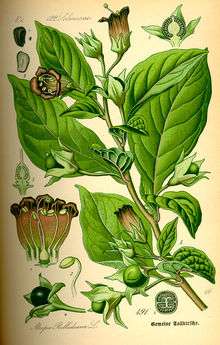

.jpg)
Typical poisonous ingredients included belladonna,[4] henbane bell, jimson weed, black henbane, mandrake, hemlock, and/or wolfsbane,[5][6][7] most of which contain atropine, hyoscyamine, and/or scopolamine.[8] Scopolamine can cause psychotropic effects when absorbed transdermally.[9] These tropane alkaloids are also officially classified as deliriants in regards to their psychoactive effects.
Extreme toxicity of active ingredients
With the exception of Potentilla reptans, the plants most frequently recorded as ingredients in Early Modern recipes for flying ointments are extremely toxic[10] and have caused numerous fatalities when eaten,[11] whether by confusion with edible species[12][13] or in cases of criminal poisoning[14] or suicide.[15] The effects of transdermal absorption of complex mixtures of the active constituents of such potentially lethal plants have not been adequately studied.
Some investigators in modern times who have sought to recreate for their own use the 'flying ointment' of times past have lost their lives in the attempt. With historian, occultist and theosophist Carl Kiesewetter of Meiningen, author of Geschichte des Neueren Occultismus 1892 and Die Geheimwissenschaften, eine Kulturgeschichte der Esoterik 1895 being one such casualty.[16]
Bodily flight versus flight in spirit
He little knows the Devil who does believe that witches and wizards can be borne through the air at wondrous speed to far distant places and there hold revels, dances and suchlike with folk of the same type[17]
the mediaeval witch-ointments...brought visionary beings into the presence of the patient, transported him to the witches' sabbath, enabled him to turn into a beast.[18]
Magic ointments...produced effects which the subjects themselves believed in, even stating that they had intercourse with evil spirits, had been at the Sabbat and danced on the Brocken with their lovers...The peculiar hallucinations evoked by the drug had been so powerfully transmitted from the subconscious mind to consciousness that mentally uncultivated persons...believed them to be reality.[19]
It has been a subject of discussion between clergymen as to whether witches were able physically to fly to the Sabbath on their brooms with help of the ointment, or whether such 'flight' was explicable in other ways: a delusion created by the Devil in the minds of the witches; the souls of the witches leaving their bodies to fly in spirit to the Sabbath; or a hallucinatory 'trip' facilitated by the entheogenic effects of potent drugs absorbed through the skin.[20][21] An early proponent of the last explanation was Renaissance scholar and scientist Giambattista della Porta, who not only interviewed users of the flying ointment, but witnessed its effects upon such users at first hand, comparing the deathlike trances he observed in his subjects with their subsequent accounts of the bacchanalian revelry they had 'enjoyed'.[22]
Body in coma and riding on beasts
anointing themselves with certain unguents...they are carried by night through the air to distant lands to do certain black magic...but nothing of this is true, though they think it to be...while they are thus dead and cold, they have no more feeling than a corpse and may be scourged and burnt; but after the time agreed upon...their senses are liberated, they arise well and merry, relate what they have done, and bring news from other lands.[Italics not original][23]
Dominican churchman Bartolommeo Spina (1465? / 1475? -1546) of Pisa gives two accounts of the power of the flying ointment in his Tractatus de strigibus sive maleficis ('Treatise on witches or evildoers') of 1525. The first concerns an incident in the life of his acquaintance Augustus de Turre of Bergamo, a physician. While studying medicine in Pavia as a young man, Augustus returned late one night to his lodgings (without a key) to find no one awake to let him in. Climbing up to a balcony, he was able to enter through a window, and at once sought out the maidservant, who should have been awake to admit him. On checking her room, however, he found her lying unconscious - beyond rousing - on the floor. The following morning he tried to question her on the matter, but she would only reply that she had been 'on a journey'.
Bartolommeo's second account is more suggestive and points toward another element in the witches' 'flights'. It concerns a certain notary of Lugano who, unable to find his wife one morning, searched for her all over their estate and finally discovered her lying deeply unconscious, naked and filthy with her vagina exposed, in a corner of the pigsty. The notary 'immediately understood that she was a witch' (!) and at first wanted to kill her on the spot, but, thinking better of such rashness, waited until she recovered from her stupor, in order to question her. Terrified by his wrath, the poor woman fell to her knees and confessed that during the night she had 'been on a journey'.
Light is cast on the tale of the notary's wife by two accounts widely separated in time but revealing a persistent theme in European Witchcraft. The first is that of Regino of Prüm whose De synodalibus causis et disciplinis ecclesiasticis libri duo (circa 906 C.E.) speaks of women who 'seduced...by demons...insist that they ride at night on certain beasts [italics not original] together with Diana, goddess of the pagans, and a great multitude of women; that they cover great distances in the silence of the deepest night...'[24] (See also Canon Episcopi).
The second account dates from some 800 years later, coming from Norway in the early 18th century and is the testimony, at the age of thirteen, of one Siri Jørgensdatter. Siri claimed that when she was seven her grandmother had taken her to the witches' sabbath on the mountain meadow Blockula ('blue-hill') : her grandmother led her to a pigsty, where she smeared a sow with some ointment which she took from a horn, whereupon grandmother and granddaughter mounted the animal and, after a short ride through the air, arrived at a building on the Sabbath mountain.[25]
Alleged sexual element in application
The hallucinations are frequently dominated by the erotic moment...in those days, in order to experience these sensations, young and old women would rub their bodies with the 'witches' salve'.[26]
the witches confess that...they anoint a staff and ride on it to the appointed place or anoint themselves under the arms and in other hairy places...[Italics not original to text].[27]
in rifleing the closet of the ladie [Alice Kyteler], they found a pipe of oyntement, wherewith she greased a staffe, upon which she ambled and galloped through thick and thin, when and in what manner she listed.[28]
Some sources have claimed that such an ointment would best be absorbed through mucous membranes, and that the traditional image of a female witch astride a broomstick implies the application of flying ointment to the vulva.[29] The passage from the trial for witchcraft in Ireland of Hiberno-Norman noblewoman Alice Kyteler in 1324 quoted above is, while not explicit, certainly open to interpretations both drug-related and sexual. It is also a very early account of such practices, pre-dating by some centuries witch trials in the early modern period. The testimony of Dame Kyteler's maidservant, Petronilla de Meath, while somewhat compromised by having been extracted under torture, contains references not only to her mistress's abilities in the preparation of 'magical' medicines, but also her sexual behaviour, including at least one instance of (alleged) intercourse with a demon.[30][31] According to the inquisition ('in which were five knights and numerous nobles') set in motion by Richard de Ledrede, Bishop of Ossory, there was in the city of Kilkenny a band of heretical sorcerers, at the head of whom was Dame Alice Kyteler and against whom no fewer than seven charges relating to witchcraft were laid. The fifth charge is of particular interest in the context of the 'greased staffe' mentioned above :
In order to arouse feelings of love or hatred, or to inflict death or disease on the bodies of the faithful, they made use of powders, unguents, ointments and candles of fat, which were compounded as follows. They took the entrails of cocks sacrificed to demons, certain horrible worms, various unspecified herbs, dead men's nails, the hair, brains, and shreds of the cerements of boys who were buried unbaptized, with other abominations, all of which they cooked, with various incantations, over a fire of oak-logs in a vessel made out of the skull of a decapitated thief.[32]
Deducting from the above ingredients of purely symbolic significance relating to death and heresy, one is left with the cooking, in a fatty mixture, of 'unspecified herbs' and 'horrible worms' to produce, among other preparations, 'unguents' and 'ointments' - one of which was the 'staffe-greasing' ointment later found in the 'pipe' discovered in Dame Alice's closet. It is unfortunate that the identities of the herbs and 'worms' involved went unrecorded. Those of the 'unspecified herbs' may well be guessed at in the light of information regarding later flying ointment recipes, but the 'horrible worms' remain more cryptic : it is unclear whether actual worms or insect larvae are intended. If the latter, such larvae might themselves have been poisonous and intoxicating, from having fed on alkaloidal plants.
Comparison of Alice Kyteler's 'staffe' and Siri Jørgensdatter's sow - both greased with a mysterious ointment, suggest the innate conservatism of European Witchcraft and the persistence of a body of women's knowledge related to sexuality and the use of a potent and complex drug.
Possible opiate component
_(20738415388).jpg)
One possible key to how individuals dealt with the toxicity of the nightshades usually said to be part of flying ointments is through the supposed antidotal reaction some of the solanaceous alkaloids have with the alkaloids of Papaver somniferum (opium poppy). This is discussed by Alexander Kuklin in his brief book, How Do Witches Fly? (DNA Press, 1999). This antagonism was claimed to exist by the movement of Eclectic medicine. For instance, King's American Dispensatory states in the entry on belladonna: "Belladonna and opium appear to exert antagonistic influences, especially as regards their action on the brain, the spinal cord, and heart; they have consequently been recommended and employed as antidotes to each other in cases of poisoning" going on to make the extravagant claim that "this matter is now positively and satisfactorily settled; hence in all cases of poisoning by belladonna the great remedy is morphine, and its use may be guided by the degree of pupillary contraction it occasions." The use of opiates in the treatment of belladonna poisoning is, however, strongly contraindicated in modern medical practice [see below].
The synergy between belladonna and poppy alkaloids was made use of in the so-called "twilight sleep" that was provided for women during childbirth beginning in the Edwardian era. Twilight sleep was a mixture of scopolamine, a belladonna alkaloid, and morphine, a Papaver alkaloid, that was injected and which furnished a combination of painkilling and amnesia for a woman in labor. A version is still manufactured for use as the injectable compound Omnopon.
There is no definite indication of the proportions of solanaceous herbs vs. poppy used in flying ointments, and most historical recipes for flying ointment do not include poppy. Furthermore, a reputable publication by the former UK Ministry of Agriculture, Food and Fisheries (now DEFRA) states specifically that, in cases of poisoning by Atropa belladonna - far from being antidotes - 'Preparations containing morphine or opiates should be avoided as they have a synergic action with atropine'; an appropriate antidote being, by contrast, the acetylcholinesterase inhibitor physostigmine salicylate.[33]
Sources citing ointments
The use by witches of flying ointments was first described, according to known sources, by Johannes Hartlieb in 1456. It was also described by the Spanish theologian Alfonso Tostado (d. 1455) in Super Genesis Commentaria (printed in Venice, 1507), whose commentary tended to accredit the thesis of the reality of the Witches' Sabbath. In 1477 Antone Rose confessed that the devil gave her a stick 18 inches in length on which she would rub an ointment and with the words "go, in the name of the Devil, go" would fly to the "synagogue" (an alternative name for Sabbath in early witchcraft).[34]
In popular culture
Drama
There is, in the work of the playwright Francisco de Rojas Zorilla (1607-1648) of Toledo, an exchange concerning the flying ointment, the (following) passage occurring in the play Lo que quería el Marqués de Villena ('What the Marquis of Villena wanted').[35]
Marquis: Others believe that witches can fly.
Zambapalo: And can't they?
Marquis: Certainly not, you ignorant fellow.
Zambapalo: Since I'm no specialist in these matters, I must ask you what happens.
Marquis: They all rub themselves with ointment.
Zambapalo: And then what?
Marquis: The ointment, which is an opiate made of henbane given them by the Devil, sends them to sleep, and they dream such a dream that they think they are not dreaming at all. And since the Devil has great power to deceive, he makes them all dream the same dream. And that is why they think they are flying through the air, when they are really fast asleep. And although they never fly at all, they think, as soon as they wake, that they have all been to see the calf, and all visited the fields at Baraona. When, by God, in reality, more than two of them have been seen sleeping in their rooms with the ointment on them.
Literature and film
- In Nathaniel Hawthorne's "Young Goodman Brown", Goody Cloyse, after meeting the Devil, says "I was all anointed with the juice of smallage, and cinquefoil, and wolf's bane" to which the Devil replies "[m]ingled with fine wheat and the fat of a new-born babe".
- In Mikhail Bulgakov's The Master and Margarita, Margarita, after agreeing to act as hostess at Dr Woland's ball, uses the ointment to become a witch and fly to the estate where the event is being held.
- In Clayton Rawson's Death from a Top Hat, two recipes by Johann Weyer, a 16th-century demonologist, are given in a footnote:
- 1-Water hemlock, sweet flag, cinquefoil, bat's blood, deadly nightshade and oil.
- 2-Baby's fat, juice of cowbane, aconite, cinquefoil, deadly nightshade and soot.
- In the movie serial Warlock, the villain kills an unbaptised boy to get this "Flying Ointment".
- In Jodi Picoult's Salem Falls, a group of four girls practicing witchcraft ingest a flying ointment made of belladonna.
- In the book Calling on Dragons (Book three of the Enchanted Forest Chronicles), the witch Morwen uses a flying potion on a straw basket and a broomstick, not on herself.
- In E. L. Konigsburg's Jennifer, Hecate, Macbeth, William McKinley, and Me, Elizabeth, two characters try to make a flying ointment.
- In the 2015 horror film The Witch, a witch kills an infant child and makes flying ointment out of his corpse.
- In the 2016 movie, The Love Witch, the main character applies a flying ointment to her body.
- In the 2019 movie, Portrait of a Lady on Fire, the two main characters apply a flying ointment to their armpits.
- In the 2020 movie, Gretel and Hansel, directed by Oz Perkins, the witch, caressing a precious jar filled with ointment, applies it to herself, and then initiates Gretel into witchcraft by inducing her to do the same.
Music
- The Bonzo Dog Doo-Dah Band song '11 Moustachioed Daughters' - a track on the Album The Doughnut in Granny's Greenhouse - is a darkly comic and surprisingly detailed evocation of the traditional Witches' Sabbath, featuring the flying-ointment-related lines :
'and belladonna, to make your eyes like a...beast's!
To anoint the body and make it shine,
To drink and make thyself divine,
To choose another's form and make it...thine!'
- The Swedish symphonic metal band Therion has a song called Unguentum Sabbati (Ointment of the Sabbat) on the album Sitra Ahra.
Gallery
 Wolfsbane or Aconite, Aconitum napellus (virulent poison)
Wolfsbane or Aconite, Aconitum napellus (virulent poison) Hemlock, Conium maculatum (virulent poison)
Hemlock, Conium maculatum (virulent poison)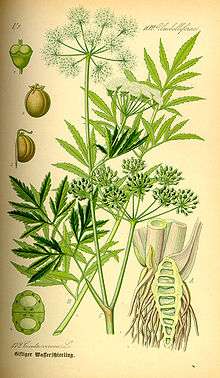 Cowbane or Water Hemlock, Cicuta virosa (virulent poison)
Cowbane or Water Hemlock, Cicuta virosa (virulent poison).jpg) Hemlock Water Dropwort or Water Hemlock, Oenanthe crocata (virulent poison)
Hemlock Water Dropwort or Water Hemlock, Oenanthe crocata (virulent poison) Greater Water Parsnip or Sium, Sium latifolium (root poisonous)
Greater Water Parsnip or Sium, Sium latifolium (root poisonous) Lesser Water Parsnip or Sium, Berula erecta
Lesser Water Parsnip or Sium, Berula erecta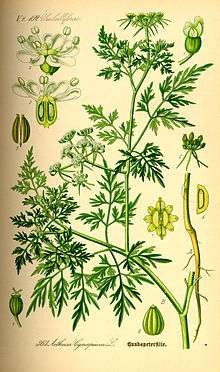 Fool's Parsley Aethusa cynapium (poison)
Fool's Parsley Aethusa cynapium (poison) Wild Celery Apium graveolens (wild form of well-known vegetable)
Wild Celery Apium graveolens (wild form of well-known vegetable) Creeping Cinquefoil, Potentilla reptans
Creeping Cinquefoil, Potentilla reptans Sweet Flag or Strewing Rush, Acorus calamus (aromatic)
Sweet Flag or Strewing Rush, Acorus calamus (aromatic)
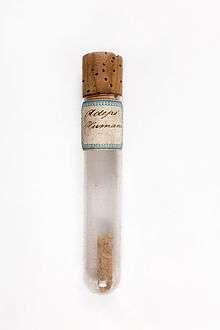
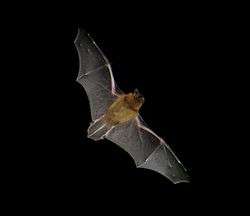 Common pipistrelle in flight (bat's blood)
Common pipistrelle in flight (bat's blood)
See also
References
- Rätsch, Christian (2005). The Encyclopedia of Psychoactive Plants: Ethnopharmacology and Its Applications. Simon and Schuster. p. 3295. ISBN 9781594776625.
- Rätsch, Christian; Müller-Ebeling, Claudia (2006). Pagan Christmas: The Plants, Spirits, and Rituals at the Origins of Yuletide. Simon and Schuster. p. 403. ISBN 9781594776601.
- Lewis Spence (1970). The Encyclopedia of the Occult. Bracken Books. p. 306 – via Internet Archive.
- Schultes, Richard Evans; Hofmann, Albert (1979). The Botany and Chemistry of Hallucinogens (2nd ed.). Springfield Illinois: Charles C. Thomas. pps. 261-4.
- Rätsch, Christian, The Encyclopedia of Psychoactive Plants: Ethnopharmacology and Its Applications pub. Park Street Press 2005
- Schultes, Richard Evans; Albert Hofmann (1979). Plants of the Gods: Origins of Hallucinogenic Use New York: McGraw-Hill. ISBN 0-07-056089-7.
- Hansen, Harold A. The Witch's Garden pub. Unity Press 1978 ISBN 978-0913300473
- Furst, Peter T. Hallucinogens and Culture pub. Chandler and Sharp 1976 (volume in series on cross-cultural themes) p.138.
- Sollmann, Torald, A Manual of Pharmacology and Its Applications to Therapeutics and Toxicology. 8th edition. Pub. W.B. Saunders, Philadelphia and London 1957.
- Tampion, John : Dangerous Plants, pub. David and Charles, Canada 1977. ISBN 0 7153 7375 7
- A Colour Atlas of Poisonous Plants : A Handbook for Pharmacists, Doctors, Toxicologists, and Biologists by Frohne, Dietrich and Pfänder, Hans Jürgen of University of Kiel, translated from second German edition by Norman Grainger Bisset, London : a Wolfe Science Book and one of the volumes in the illustrated series Wolfe Atlases, pub. Wolfe Publishing Ltd. 1984.
- Mateo Montoya, A; Mavrakanas, N; Schutz, JS (2009). "Acute anticholinergic syndrome from Atropa belladonna mistaken for blueberries". Eur J Ophthalmol. 19 (1): 170–2. doi:10.1177/112067210901900130. PMID 19123171.
- "The POISON GARDEN Website blog - 28th November 2015". Thepoisongarden.co.uk. Retrieved 12 March 2019.
- Schenk, Gustav Das Buch der Gifte translated by Michael Bullock as The Book of Poisons pub. Weidenfeld and Nicolson 1956 page 28, re. A. belladonna as Lithuanian criminal poison 'Maulda'.
- Demirhan, A; Tekelioğlu, ÜY; Yıldız, İ; Korkmaz, T; Bilgi, M; Akkaya, A; Koçoğlu, H (2013). "Anticholinergic Toxic Syndrome Caused by Atropa Belladonna Fruit (Deadly Nightshade): A Case Report". Turk J Anaesthesiol Reanim. 41: 226–8. doi:10.5152/TJAR.2013.43. PMC 4894214. PMID 27366377.
- Bert-Marco Schuldes: Psychotropicon zum Bilsenkraut und dem Tod Kiesewetters. In: Psychotropicon. Das Online-Magazin für Psychonauten vom 5. März 2012.
- Bishop Jesper Brocmand, Systema universae theologiae 1633
- Tylor, Edward B.1924 Primitive Culture : Researches into the Development of Mythology, Philosophy, Religion, Language, Art, and Custom 2 vols. (combined) pub. New York : Brentano's. Originally published 1871.
- Lewin, Louis Phantastica, Narcotic and Stimulating Drugs : Their Use and Abuse. Translated from the second German edition by P.H.A. Wirth, pub. New York : E.P. Dutton. Original German edition 1924.
- "Witches Gallery". Bristol Radical History Group. Retrieved 19 July 2017.
- Harner, Michael J., Hallucinogens and Shamanism, pub. Oxford University Press 1973, reprinted U.S.A.1978 Chapter 8 : pps. 125-150 : The Role of Hallucinogenic Plants in European Witchcraft.
- John Baptista Porta (1584). Magiae naturalis. Archived from the original on 16 May 2008.CS1 maint: BOT: original-url status unknown (link)
- Ciruelo,Pedro : Tratado en el cual se repruevan todas las supersticiones y hechizerías, pub. Barcelona 1628, P.II, c. 1, N. 6, pps. 45-46, quoted in H.C. Lea : Materials Toward a History of Witchcraft, pub. Thomas Yoseloff New York and London 1957, page 413.
- Quoted in : Ginzburg, Carlo, Ecstasies. Deciphering the Witches' Sabbath, New York, 1991, ISBN 0-226-29693-8. First published in Italian as Storia notturna: Una decifrazione del Sabba, 1989.
- Quoted in Pickering, David : A Dictionary of Witchcraft pub. David Pickering 2014.
- Hesse, Erich, Narcotics and Drug Addiction pub. New York : Philosophical Library 1946
- Bergamo, Jordanes de, Quaestio de Strigis (Unpublished manuscript, Bibliothèque Nationale, Paris), quoted in Joseph Hansen Quellen und Untersuchen zur Geschichte des Hexenwahns und der Hexengefolgung im Mittelalter pps. 195-200. Pub. 1901 [1905]. Bonn : Carl Georgi.
- Wright, Thomas, ed. A Contemporary Narrative of the Proceedings Against Dame Alice Kyteler, Prosecuted for Sorcery in 1324, by Richard de Ledrede, Bishop of Ossory. London: The Camden Society, 1843.
- Emboden, William Narcotic Plants : Hallucinogens, stimulants, inebriants, and hypnotics, their origins and uses 2nd edition (revised and enlarged) pub. Macmillan, New York 1979 ISBN 0-02-535480-9 p.127
- Williams, Bernadette, 'The Sorcery Trial of Alice Kyteler,' History Ireland Vol. 2, No.4 (Winter, 1994)
- Davidson, Sharon, and John O. Ward, trans. The Sorcery Trial of Alice Kyteler: A Contemporary Account (1324). Asheville, NC: Pegasus Press, 2004.
- Seymour, St. John D. Irish Witchcraft and Demonology pub. Dorset Press 1992 ISBN 0-88029-734-4
- Cooper, Marion R. and Johnson, Anthony W. Poisonous Plants in Britain and their effects on Animals and Man, Ministry of Agriculture Fisheries and Food Reference Book 161 (replacing Bulletin 161) pub. HMSO London, 1984 ISBN 0 11 242529 1 page 213
- Encyclopedia of witchcraft and demonology, Page 50, octopus, 1974
- Quoted in : Baroja, Julio Caro The World of the Witches pub. Phoenix 2001 (Original Title Las brujas y su mundo) ISBN 9781842122426)
External links
- Flying Potions and Getting to the Sabbat
- Belladonna in flying ointments
- Ritual of the Raven
- If Witches No Longer Fly: Today's Pagans and the Solanaceous Plants
- King's American Dispensatory on Belladonna
- FLYING OINTMENTS: Their Ingredients and Their Use
- Witches' Ointment: Information from the Gale Encyclopedia of Occultism & Parapsychology